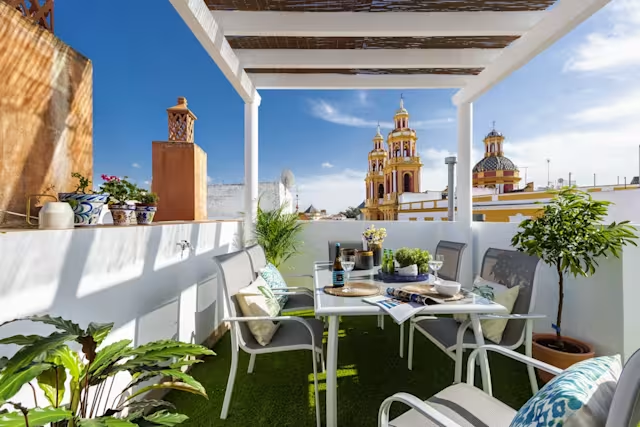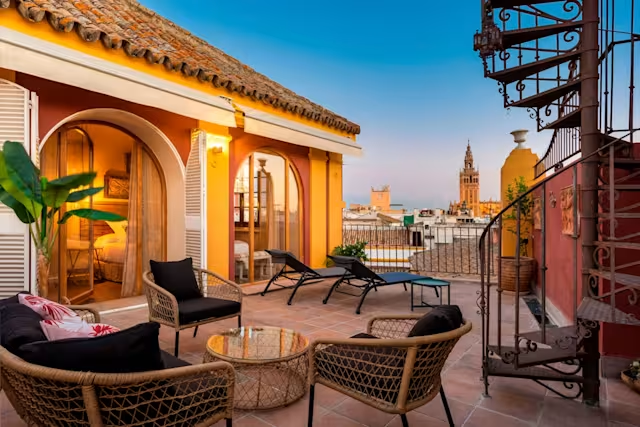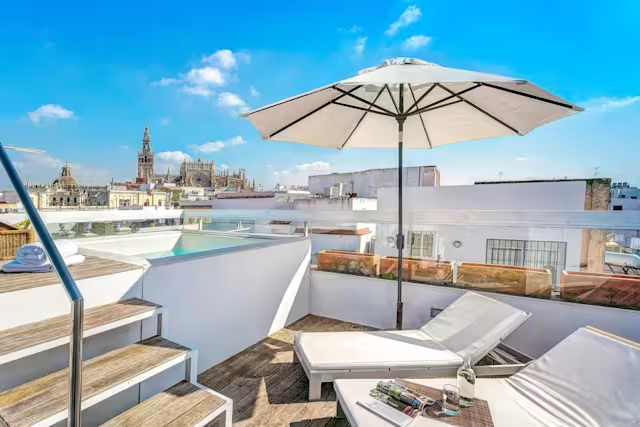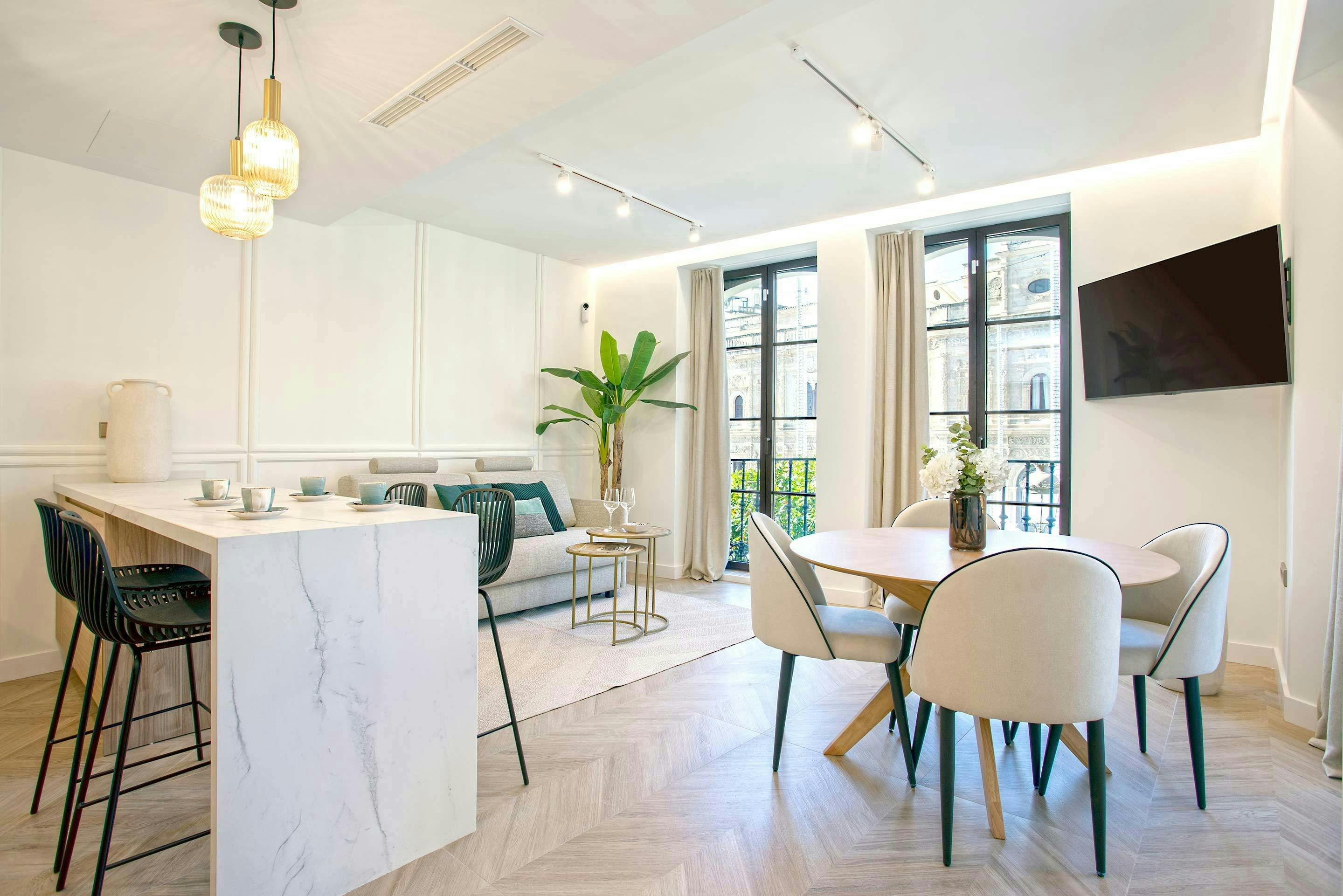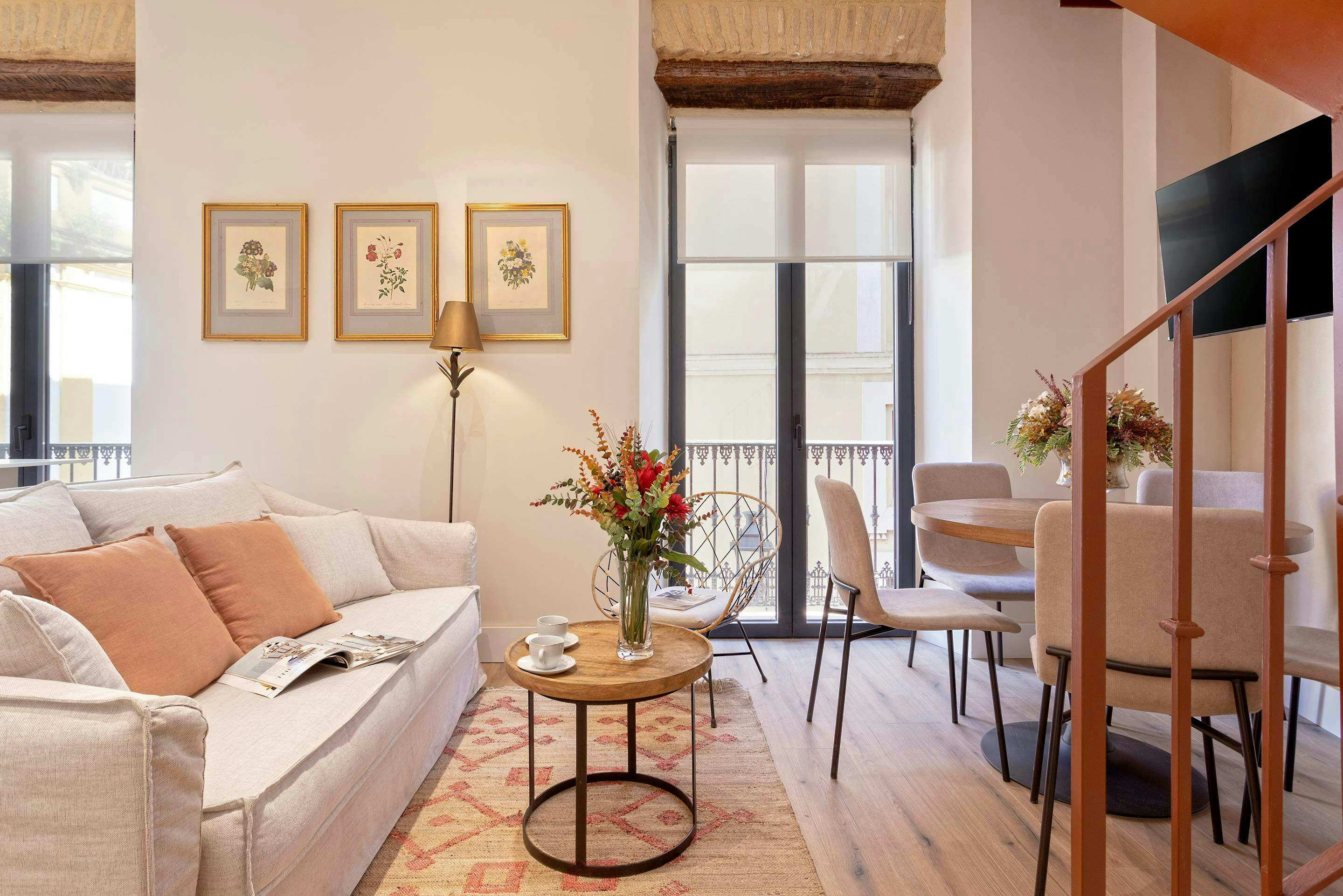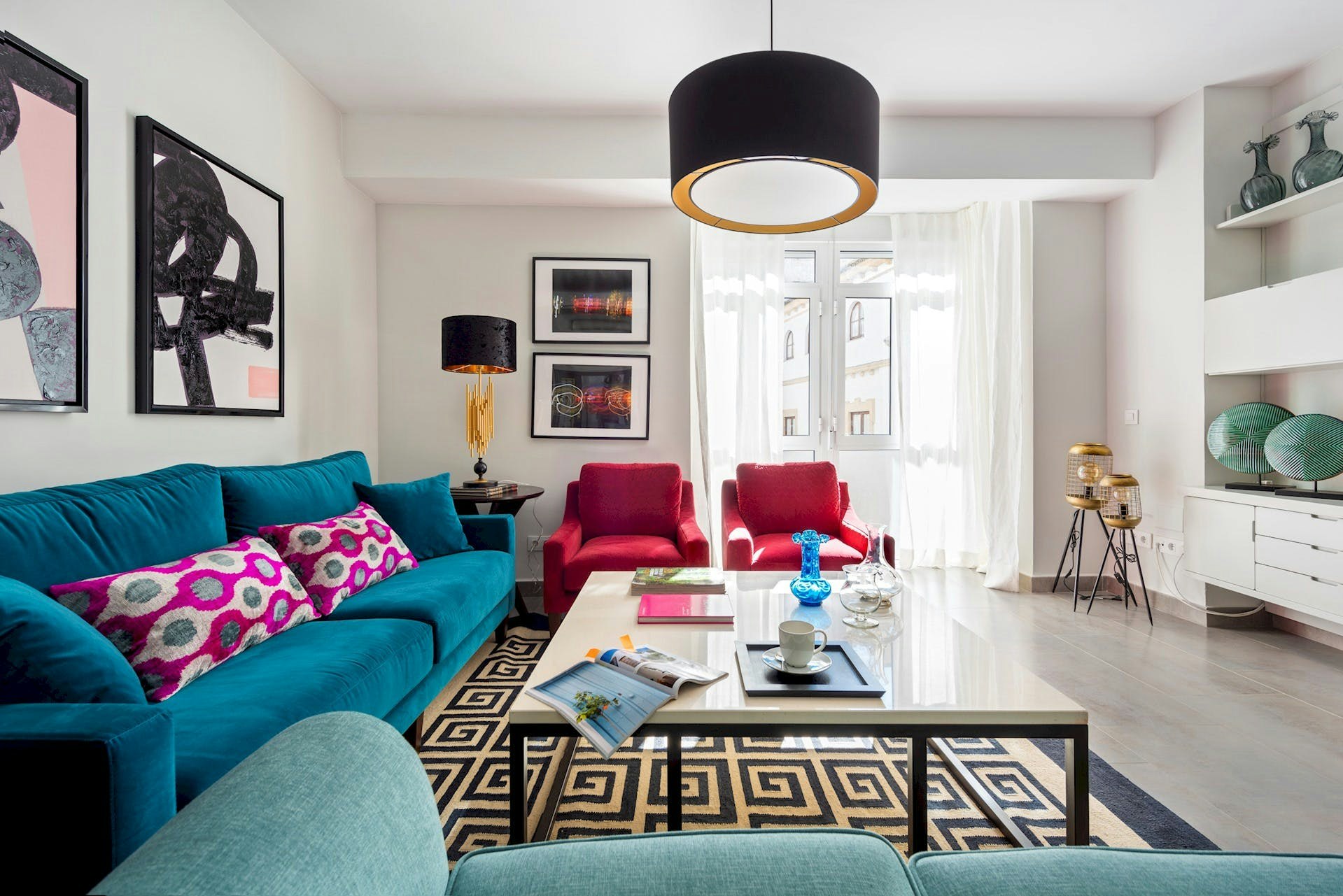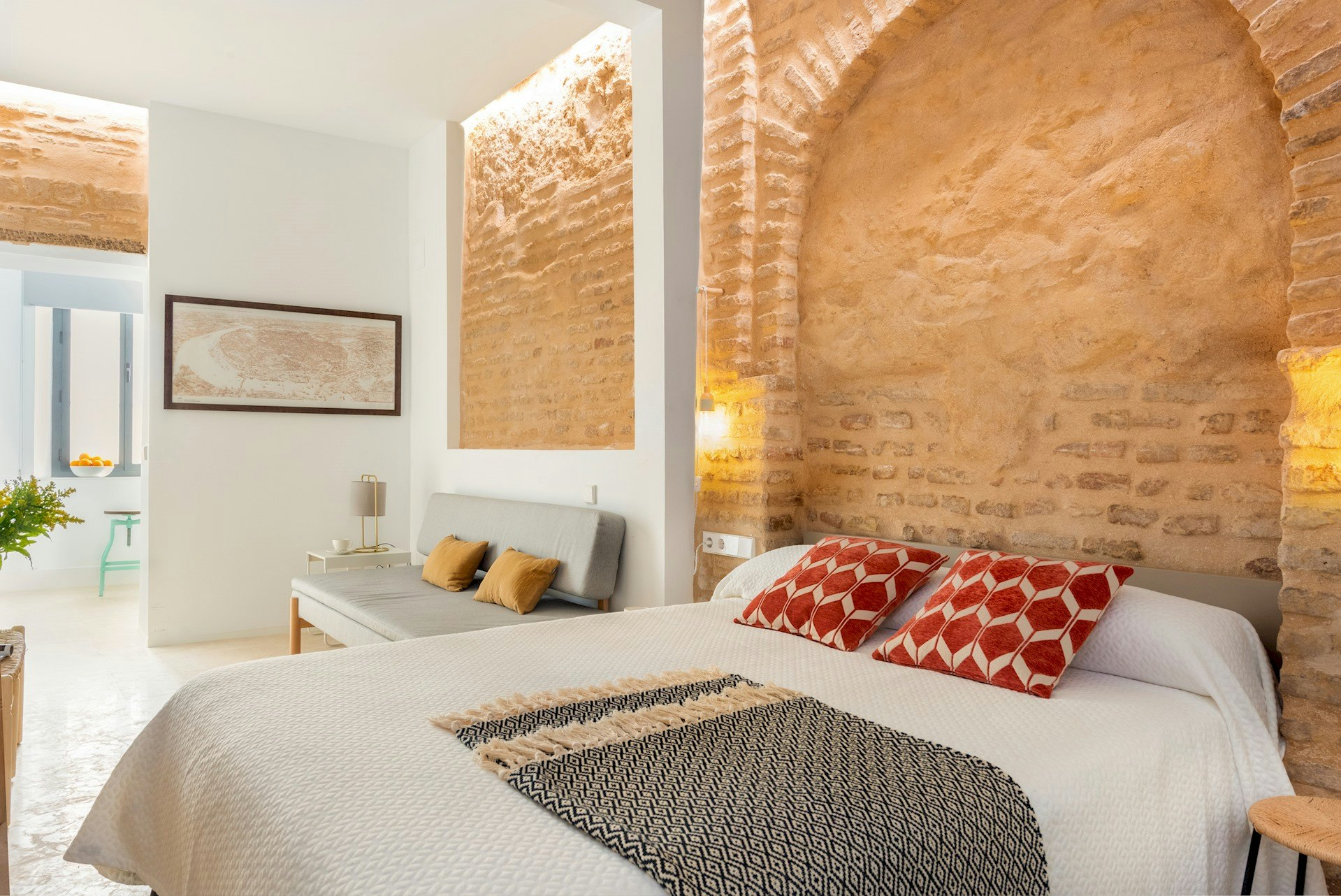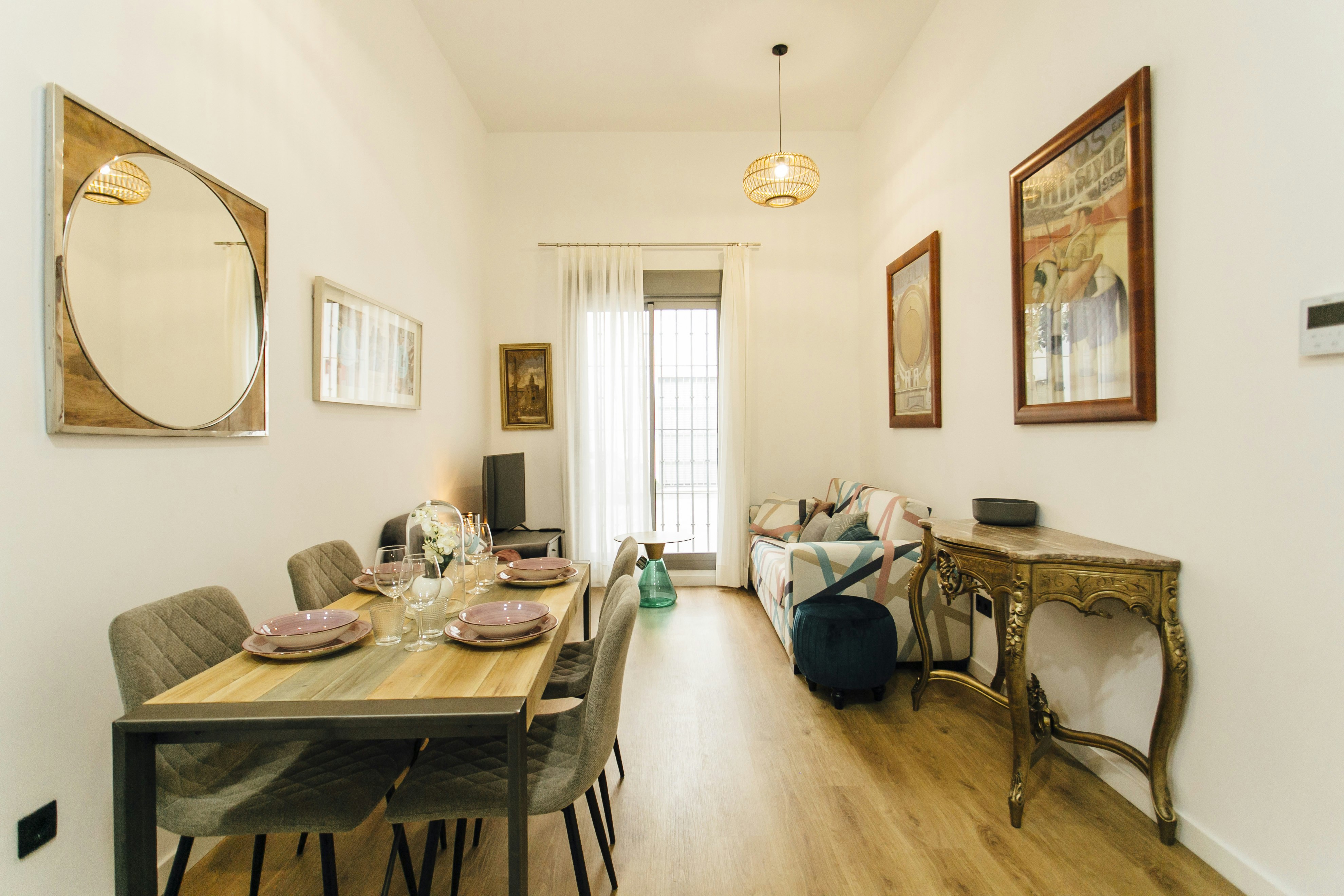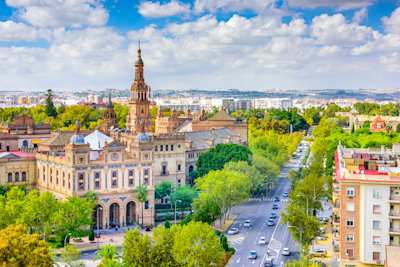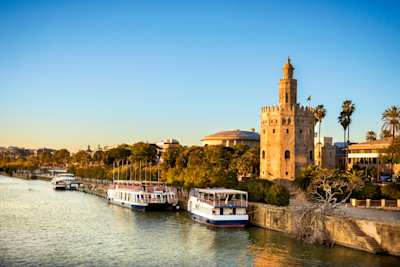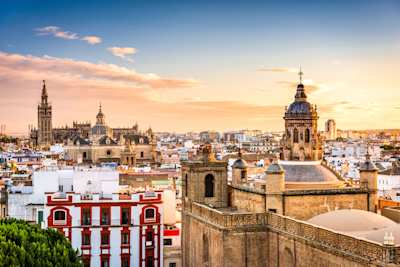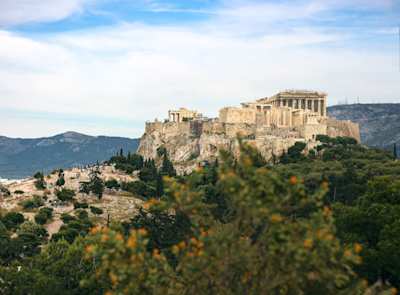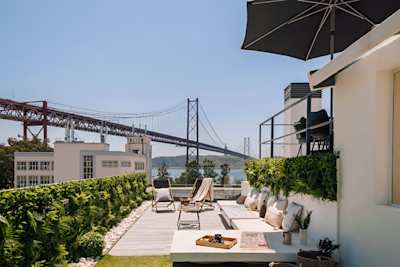From Flamenco to Festivals: An Expert Travel Guide to Seville
Here’s everything you need to know about travelling to Andalusia’s beating heart
~
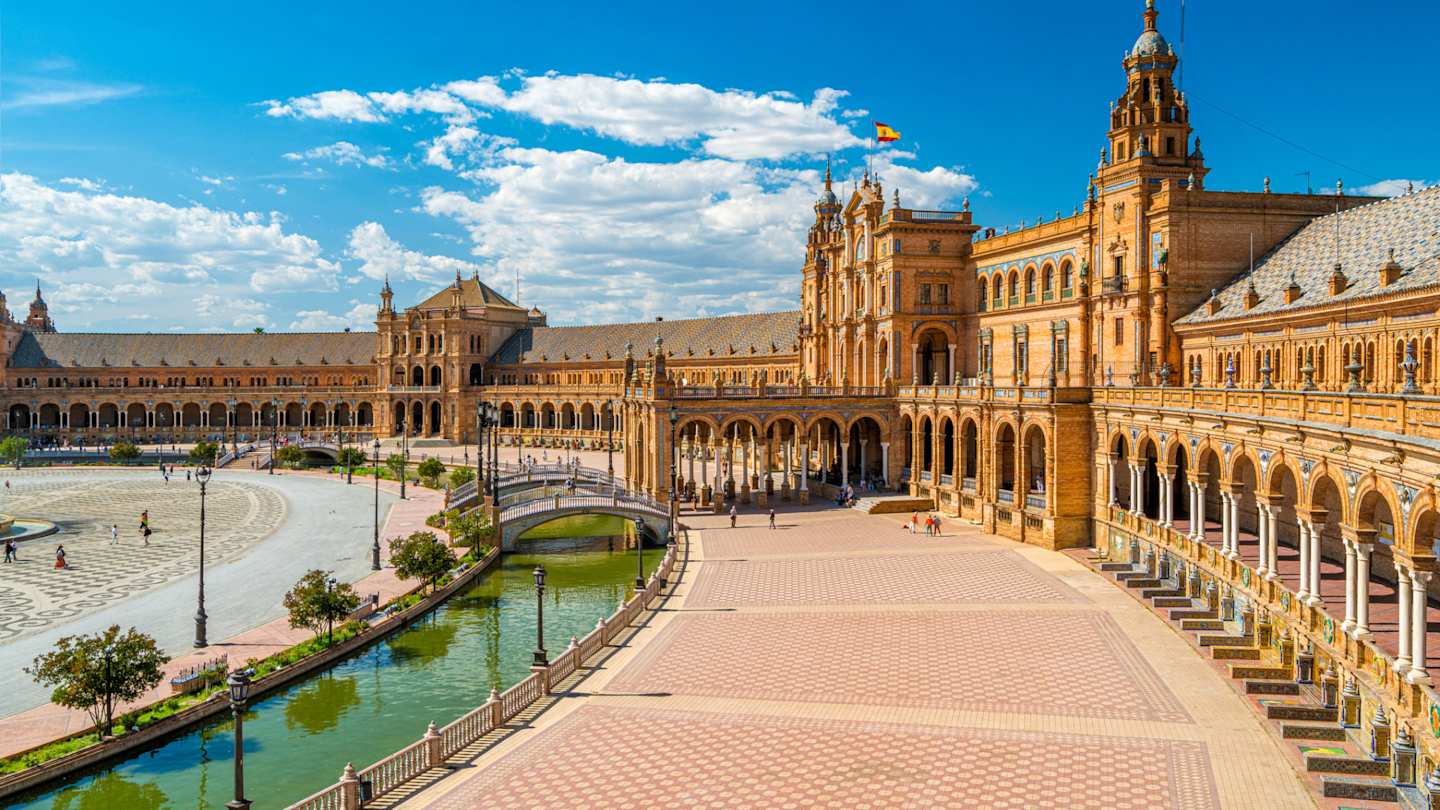
Oh, Seville. It’s impossible not to be swept off your feet by this city’s charm. It has everything you could ever want in a holiday destination – friendly people, delicious food and drink, sunny weather and unique attractions. Thinking of a trip here? The experts at Plum Guide have all the essential information on the city, including what to do and where to stay, eat and play. If you’d rather be packing your bags than doing hours of destination research, don’t worry – we’re here to help you plan the perfect trip with our comprehensive travel guide to Seville.
General info about Seville

A view of the tower of a cathedral behind oranges growing on trees, Seville, Spain
What better destination for history buffs than Seville? Dating back over 2,000 years, Seville has a long and intriguing past. It’s one of the oldest cities in Spain, having been inhabited by various civilisations over the years, including the Romans, Christians and the Moors. The Moors arrived in the 8th century – it was during this period when Seville grew into a thriving cultural and economic centre, with the construction of impressive buildings like the Royal Alcázar.
Best time to visit Seville
Bathed in year-round sunshine, there's never a bad time to visit Seville. Spring is best for catching some of the city’s most famous festivals (more on that later). Early summer and autumn are better for outdoor activities, as the weather is pleasant and you can avoid the soaring temperatures of July and August. Winter (December and January) are much cooler with a few showers, but if you don’t mind layering up, it’s worth visiting to see Seville’s festive lights and seasonal markets.
How to get to Seville
Seville is home to an international airport – the Seville Airport (SVQ) – which has direct flights to many European cities. However, the best way to get to Seville is by train, with the Santa Justa station offering high-speed connections to many other cities in Spain. Seville is also well-connected to other Spanish and European cities by bus, and the main bus station is the Plaza de Armas in the city centre.
Top activities and attractions
Gorgeous architecture
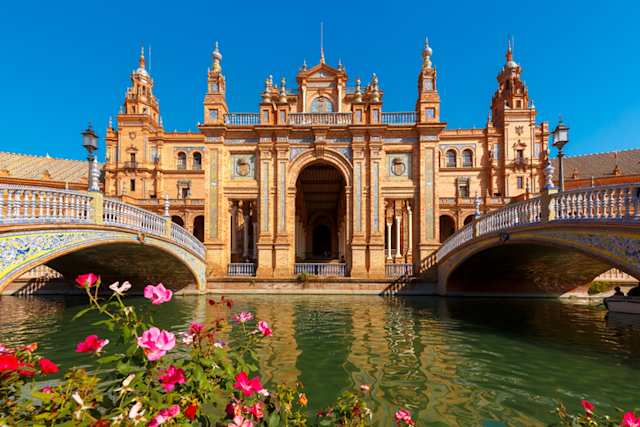
Plaza de España on a sunny day, with flower beds, bridges and water in the foreground, Seville
Lovers of fine architecture will be in absolute heaven here in Seville. Its long and varied history is reflected in the city’s buildings, with everything from imposing Gothic buildings to romantic squares like the Plaza de España. One of the most striking architectural wonders is the Royal Alcázar, originally built by the Moors in the 14th century and featuring intricate tilework, arches, courtyards, gardens and water features. Another masterpiece is Catedral de Sevilla, the largest Gothic cathedral in the world with some of the most incredible interiors you've ever seen.
Flamenco shows
Flamenco is one of Seville’s most famous customs. Originating between the 9th and 14th centuries, this traditional music, song and dance form blends influences from Moorish, Jewish and Romani cultures. Characterised by intense footwork, hand clapping and passionate expressions, no visit would be complete without experiencing a show. Some of the most well-known venues include Tablao El Arenal, Casa de la Memoria, and El Patio Sevillano.
Museums and galleries
Seville has a museum and gallery for everyone, whether you’re interested in classic art or science. Learn more about flamenco at the Museo del Baile Flamenco, or check out traditional Andalusian fashion at the Museo de Artes y Costumbres Populares. Prefer historical ruins instead? Marvel at Roman remains at the Museo Antiquarium. For art enthusiasts, the Museum of Fine Arts (Museo de Bellas Artes de Sevilla) has one of the most important art collections in the whole of Spain, with a focus on Sevillan and Spanish art between the medieval period and the 20th century.
Vibrant markets
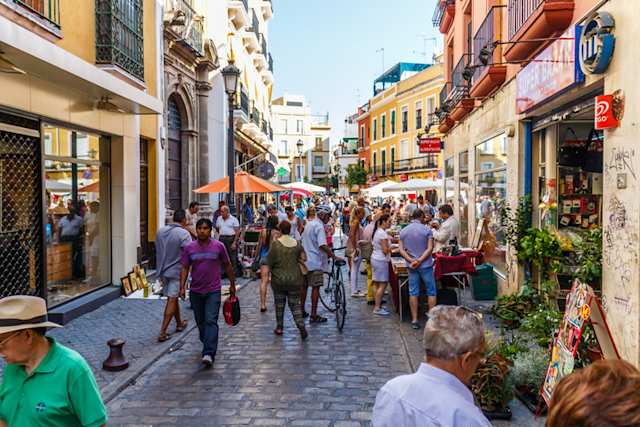
People browsing the colourful market stalls at a street-wide flea market in old town, Seville
Get a taste of local life with a trip to Seville’s bustling markets. Mercado de Feria is one of the city’s oldest and most popular markets, where you can browse the stalls of fresh produce and snack on traditional dishes like fish, paella and arepa. Mercado de Triana is another must-visit, a sprawling indoor bazaar set within the old Moorish fort of Castillo de San Jorge. If cured Iberian ham is your weakness, you’re in the right place. For antiques, crockery and other knick-knacks, the Thursday-only Mercadillo del Jueves is a huge open-air flea market with over 120 stalls.
Colourful festivals
If you’re ever in need of a pick-me-up, Seville is the best place for it. It’s home to a variety of lively festivals throughout the year, one of the largest being Semana Santa (Easter Week). This is a week-long celebration where a spectacular procession of masked penitents and huge floats take over the city. Another popular festival is Feria de Abril (April Fair). Also lasting an entire week, this exciting event celebrates Sevillian culture with copious amounts of dancing, singing, eating and drinking.
Hidden gems
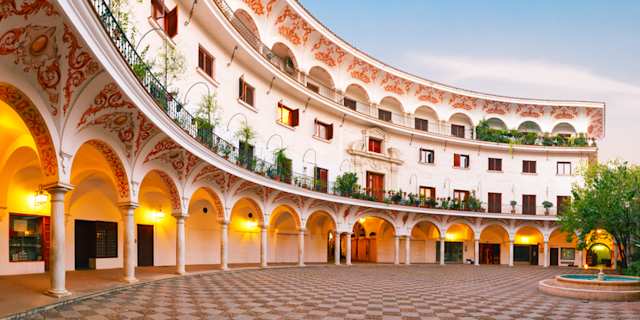
Panorama of picturesque curved Plaza del Cabildo in the morning light, Seville
What would a travel guide to Seville be without a few hidden gems? While Seville sees over 2 million tourists a year, it’s still possible, believe it or not, to find places off the beaten track. One of our favourite spots in the city is La Bicicletería, a quirky bar tucked away on Feria Street. Ring the bell and a friendly doorman will grant you entry into this Twilight Zone-like land of bizarre decorations and moody lighting. If you visit on the right night, you’ll also catch live music performances.
Another hidden gem is the stunning Plaza del Cabildo, a unique circular plaza with frescoed arcades supported by marble columns. Despite its location near the cathedral, the plaza is easy to miss as you need to enter through a passageway at the Avenida de la Constitución.
Best areas to visit and stay in
Barrio Santa Cruz
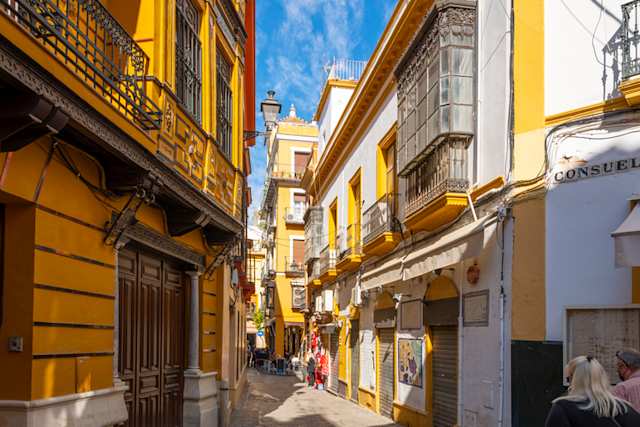
A charming street of shops, homes and cafes in the Barrio Santa Cruz district, Seville
Formerly the Jewish Quarter of Seville during medieval times, Barrio Santa Cruz is the most charming neighbourhood in the city. A maze of ancient streets leads to pretty plazas – our favourites are Plaza de doña Elvira or Plaza de Santa Cruz, where you can admire gorgeous Moorish architecture. You’ll also find many of the city’s top attractions here, such as Catedral de Sevilla and the Royal Alcázar.
Triana
The historic neighbourhood of Triana has a very distinct character, and is known for its ceramics, flamenco dancing and lively markets. Its most popular attraction is the Triana Bridge which boasts scenic views of the city. Running along the river is Calle Betis, lined with colourful buildings, shaded trees and alfresco bars where you can enjoy a glass of wine with a side of river views.
El Arenal
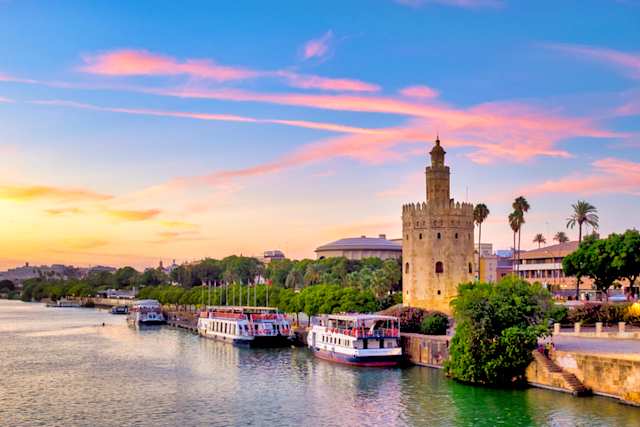
Torre del Oro and sightseeing boats on the Guadalquivir River at dusk, Seville
On the banks of the Guadalquivir River is El Arenal, Seville’s former port area. It’s more residential, offering a more peaceful experience. Make the most of your surroundings with a boat tour down the river where you can find out how it played an important role in Seville’s history. Don’t forget to bring your camera as you’ll cruise past some of Seville’s most iconic landmarks like the Torre del Oro and the Maestranza Bullring, as well as beautiful bridges that span the river.
Los Remedios
Searching for peace and quiet but with easy access to Seville’s pulsing centre? Los Remedios is a mostly residential area with wide boulevards, elegant buildings and pretty gardens. It’s home to Parque de los Príncipes, a huge park complete with stunning gardens, a lake and a children’s playground. Los Remedios is also where the Feria de Abril (April Fair) takes place, so if you’re here for the festivities, then this is the place to be.
Macarena
Macarena has a laid-back, residential feel. The neighbourhood’s most famous landmark is the Basílica de la Macarena, a striking Baroque church dedicated to the Virgen de la Macarena. The church is home to a beautiful 17th-century statue of the Virgin, which is paraded through the streets during the famous Semana Santa (Holy Week) festival.
Eating out in Seville
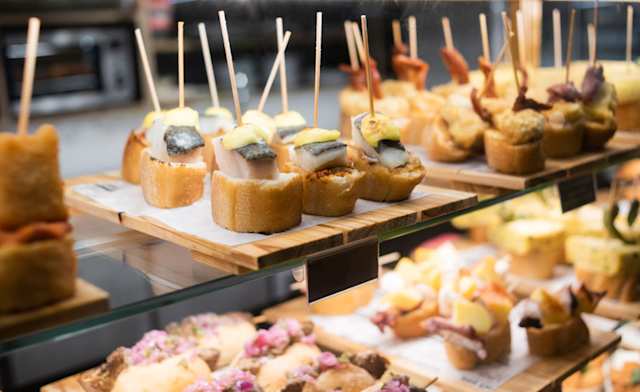
Close-up of tapas, including pinchos, at a tapas bar in Seville
Food is an important part of any travel, and we couldn’t leave it off our travel guide to Seville. The city’s cuisine is largely influenced by the region’s history and culture, taking influences from the Moors, Romans and even the New World. Tapas is one of the most famous, of course – these are quintessential Spanish small plates of food (like bar snacks) which are perfect for sharing and can be combined to form a full meal.
Local delicacies
Local delicacies to make note of include salmorejo (tomato soup made with bread, olive oil and garlic – a thicker and creamier version of gazpacho), carrillada (braised beef cheeks or Iberian pork cheeks), rabo de toro (bull tail stew), croquetas de puchero (beef, pork, cured sausages and pork fat fried balls) and albóndigas de choco (squid or cuttlefish meatballs). Pinchos (also called pintxos in Basque Country where they originated) are small slices of bread topped with various ingredients. They're the perfect Spanish bite.
Where to find food
Seville is a gastronomic city, so the good news is you’ll never go hungry. As well as the many food markets, family-run eateries and Michelin-star restaurants, you also have the ubiquitous tapas bars. One of the best things to do is go on a tapas bar crawl, where you can try different dishes at different places (each bar usually has its own speciality). Some of our favourite tapas bars include La Brunilda Tapas, La Linterna Ciega, La Malvaloca, La Sede and Bar Catedral Sevilla.
